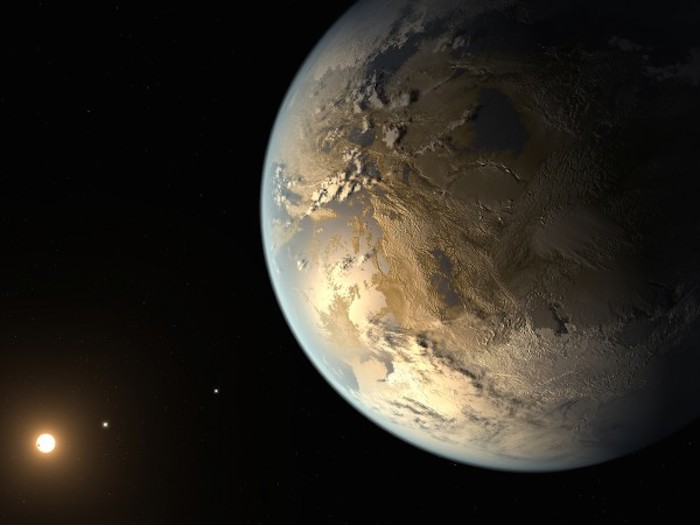.

SEATTLE, WASHINGTON—Only a small number of worlds around other stars look anything like Earth: roughly the same size and at the right distance from their star for liquid water to be present. But are these Earth-like exoplanets really made from the same sort of stuff—a rocky surface, an iron core, and just a dash of water? A study presented here today at a meeting of the American Astronomical Society suggests that exoplanets, at least up to 1.6 times the mass of Earth, follow pretty much the same recipe as our home. So if we’re looking for life out there, we can probably ignore anything bigger than that.
NASA’s Kepler satellite has detected the greatest number of exoplanets. It detects them by the dip in brightness they cause when they pass in front of their parent star. This decrease allows researchers to deduce the diameter of the planet but not its mass. Measuring mass requires an entirely different technique. As an exoplanet orbits its star, its own gravity makes the star wobble back and forth very slightly—the heavier the star, the greater the wobble. Astronomers can measure the wobble by measuring the frequency of a star’s light very accurately with an instrument called a spectrograph. When the star is wobbling away from Earth its light is stretched out and reduced in frequency; when it moves toward us, the light is bunched up and its frequency increases.
Astronomers have been studying exoplanets this way for years, but a team led by astronomer Courtney Dressing of the Harvard-Smithsonian Center for Astrophysics (CfA) in Cambridge, Massachusetts, used a new spectrograph called HARPS-North, attached to Italy’s Galileo National Telescope in the Canary Islands, to measure the mass of a group of small exoplanets—which produce smaller wobbles—more accurately than ever before.
The team calculated the masses of 10 known exoplanets with diameters that are less than 2.7 times that of Earth. Plotting the mass results against the planets’ diameters, the researchers found that the five smallest exoplanets—all less than 1.6 times Earth’s diameter—lay on the curve typical of a largely rocky planet with an iron core, the same curve that Earth and Venus sit on. “This suggests that they have the same recipe as Earth,” Dressing told a press conference here today.
In contrast, the five larger exoplanets turned out to have significantly lower densities, suggesting that they contained more lighter material, or “fluffy stuff” as Dressing termed it, that could include water, hydrogen, or helium. There are outliers among low mass worlds that also have low density, but "to find truly Earth-like worlds, we should focus on planets less than 1.6 times the size of Earth, because those are the rocky worlds," Dressing said.
Astronomer Debra Fischer of Yale University told the conference that the results “make sense.” The fact that “they lie along a line is extremely suggestive. Not a lot of things are falling off the line,” she says. Astronomer Sara Seager of the Massachusetts Institute of Technology in Cambridge agrees. “It’s great to see such accurate measurement of exoplanets, and the potential that high-accuracy planetary masses and radii can actually tell us something about planet formation is promising,” she says. Other studies have also suggested that 1.6 times the size of Earth may be a dividing line between rocky and more gassy planets. “It's good to see yet another line of evidence that about 1.6 Earth radii is the cut off,” Seager says.
For those that want to cook up their own Earth-like planet, Dressing proposed a recipe:
Makes one small model planet
Ingredients:
1 cup magnesium
1 cup silicon
2 cups iron
2 cups oxygen
1/2 teaspoon aluminum
1/2 teaspoon nickel
1/2 teaspoon calcium
1/4 teaspoon sulfur
Dash of water delivered by asteroids
Blend well in a large bowl, shape into a round ball with your hands, and place neatly in a habitable zone area around a young star. Do not overmix. Heat until mixture becomes a white hot glowing ball. Bake for a few million years. Cool until color changes from white to yellow to red and a golden-brown crust forms. It should not give off light anymore. Season with a dash of water and organic compounds. It will shrink a bit as steam escapes and clouds and oceans form. Stand back and wait a few more million years to see what happens. If you are lucky, a thin frosting of life may appear on the surface of your new world.
Quelle: AAAS
4840 Views
